The automotive industry is undergoing a transformative phase, driven by groundbreaking innovations that promise a future of safer, greener, and more connected transportation. Electric vehicles, autonomous driving, connected cars, advanced driver assistance systems, augmented reality, vehicle-to-vehicle communication, and energy-efficient technologies are reshaping the way we drive and paving the way for a new era of mobility. These advancements contribute to sustainability, minimize the environmental impact of transportation, and provide a safer and more enjoyable driving experience.
Key Takeaways
- The automotive industry is revolutionized by advancements in electric vehicles, autonomous driving, and connected car technology.
- These innovations promise a future of safer, greener, and more connected transportation.
- Emerging technologies such as advanced driver assistance systems, augmented reality, and vehicle-to-vehicle communication are transforming the driving experience.
- Sustainability and environmental impact reduction are key drivers of these technological advancements.
- Careers in the automotive industry, automotive technology, and automotive service are growing in demand.
The Transformative Power of Electric Vehicles
As the automotive industry transitions from internal combustion engines to hybrid and all-electric propulsion, the development of advanced battery technologies and efficient electric motors has become crucial. Innovations in battery design, energy storage materials (such as lithium-ion and solid-state electrolytes), electric chargers, and EV drivetrains are contributing to increasingly affordable and efficient alternatives to traditional vehicles.
Advanced Battery Designs
Researchers and manufacturers are exploring novel battery technologies, including solid-state batteries, to improve energy density, charging speed, and overall performance of electric vehicles (EVs). These advanced battery designs aim to address the limitations of existing lithium-ion batteries, paving the way for EVs with longer range and faster charging capabilities.
Longer Ranges and Faster Charging
Advancements in battery management systems (BMS) and thermal management techniques are enabling EVs to achieve longer driving ranges on a single charge, while electric chargers are becoming more powerful, allowing for quicker replenishment of the vehicle’s energy storage. These improvements are crucial in addressing consumer concerns about EV practicality and driving experience.
Sustainable Transportation Solutions
The shift towards electric vehicles is driven by a growing focus on sustainability and environmental impact. Governments and policymakers are implementing initiatives to encourage the adoption of EVs, while consumer demand for cleaner, more efficient transportation options continues to rise. Powertrain electrification and advancements in battery technology are enabling the automotive industry to deliver sustainable transportation solutions that address the pressing need for eco-friendly mobility.
Autonomous Driving: The Next Frontier
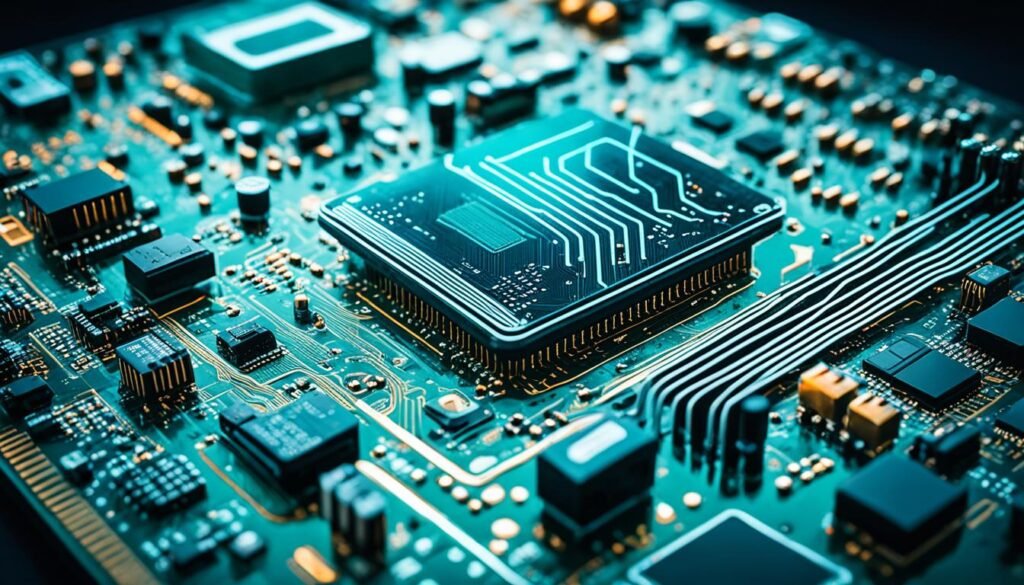
The automotive industry is on the cusp of a revolution in transportation, driven by the rapid advancements in autonomous driving technology. Autonomous, or self-driving, vehicles have the potential to transform the way we commute and reshape the entire transportation ecosystem. At the heart of this transformation lies the seamless integration of sensor fusion and artificial intelligence (AI).
Sensor Fusion and AI Integration
Autonomous vehicles rely on a sophisticated array of sensors, including lidar, radar, cameras, GPS, and inertial measurement units (IMUs), to perceive their surroundings. These sensors work in tandem, a process known as sensor fusion, to create a comprehensive, real-time understanding of the vehicle’s environment. Artificial intelligence, powered by advanced algorithms and machine learning, then processes this data, enabling the vehicle to make informed decisions and navigate safely without human intervention.
Levels of Automation and Driver Assistance
The autonomous driving landscape is often divided into distinct levels, ranging from basic driver assistance systems to fully driverless vehicles. Advanced driver assistance systems (ADAS), such as lane departure warning, adaptive cruise control, and automatic emergency braking, represent the initial steps towards autonomous driving. As technology continues to evolve, higher levels of automation, including partial and full self-driving capabilities, are becoming a reality, transforming the role of the driver and the overall driving experience.
The autonomous driving market is poised for significant growth, driven by advancements in sensor technologies, AI software, and regulatory frameworks. However, the widespread adoption of autonomous vehicles also raises important considerations, such as liability, insurance, and the need for comprehensive regulation to ensure the safety and security of both drivers and pedestrians.
Connected Cars and V2X Communication

The integration of vehicles with the internet and other devices, known as connected cars, is revolutionizing the driving experience. Connected cars can communicate with each other and surrounding infrastructure through Vehicle-to-Everything (V2X) communication, enabling the real-time exchange of valuable information such as traffic conditions, road hazards, and weather updates.
Real-time Traffic and Road Condition Data
By leveraging dedicated short-range communication (DSRC) and emerging 5G connectivity, connected cars can receive and share real-time data about traffic flow, congestion, and road conditions. This information allows drivers to make informed decisions, optimize their routes, and avoid potential delays or safety hazards. The seamless integration of vehicle-to-infrastructure and vehicle-to-vehicle communication enhances overall traffic flow and safety, benefiting both individual drivers and the broader transportation network.
Enhanced Infotainment and Remote Control
Connected cars also offer a range of personalized services and features through advanced infotainment systems. Drivers can access a wealth of information, entertainment, and connectivity options, including subscription-based features and the ability to remotely control various aspects of their vehicle, from climate settings to door locks. This increased customer awareness and connectivity ultimately enhances the overall driving experience, catering to the evolving needs and preferences of modern consumers.
Advanced Driver Assistance Systems (ADAS)
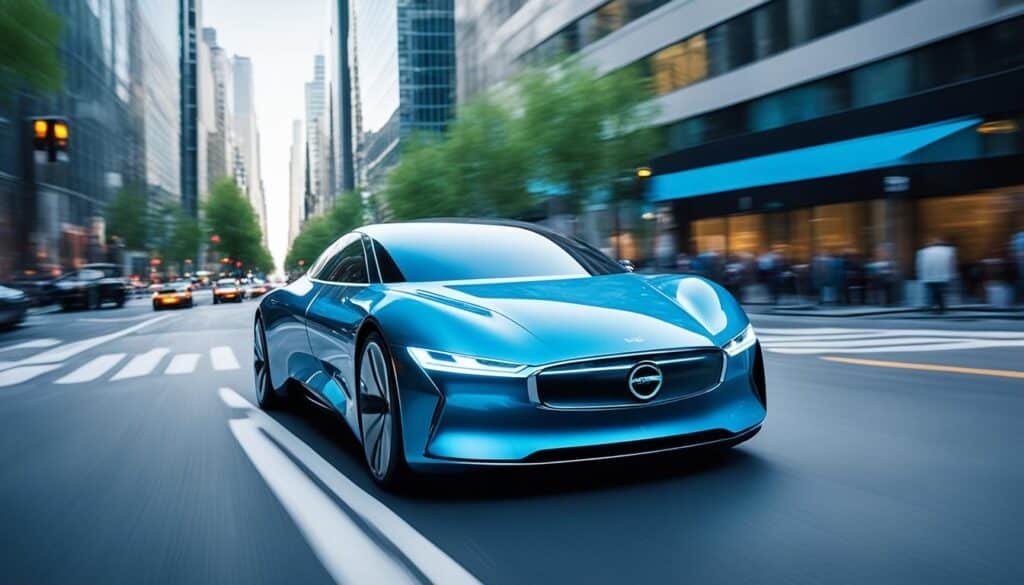
The automotive industry has seen remarkable advancements in advanced driver assistance systems (ADAS), which are designed to enhance driver safety and comfort. These sophisticated technologies leverage a range of sensor technologies, including cameras, radar, and lidar, to monitor the driving environment and provide timely warnings, alerts, and interventions when necessary.
Collision Avoidance and Mitigation
Collision warning and collision avoidance systems are at the forefront of ADAS, helping drivers navigate safely and preventing accidents. Automatic emergency braking systems can detect potential collisions and apply the brakes automatically, reducing the severity of impact or avoiding it altogether. These systems rely on advanced sensor fusion and real-time data analysis to identify hazards and respond accordingly, significantly improving road safety.
Lane Departure Warning and Assistance
Lane departure warning and lane departure assistance systems use camera technology to monitor the vehicle’s position within the lane and provide alerts or interventions when the driver unintentionally drifts out of the lane. These systems can help mitigate the risks associated with drowsiness, distraction, or unintentional lane changes, enhancing the overall driver experience and road safety.
Blind Spot Monitoring
Blind spot monitoring systems leverage radar and camera technologies to detect vehicles in the driver’s blind spots, alerting them to the presence of other cars or cyclists in adjacent lanes. This feature can significantly improve lane change maneuvers and reduce the risk of collisions, contributing to a safer and more confident driving experience.
Augmented Reality and Heads-Up Displays

The automotive industry is embracing the transformative power of augmented reality (AR) and heads-up displays (HUDs) to enhance the driver experience and minimize distractions. These innovative technologies are poised to redefine the way drivers interact with critical information while on the road.
Intuitive Navigation and Information Overlay
AR overlays digital information, such as turn-by-turn navigation instructions, speed limits, and hazard alerts, directly onto the driver’s field of vision, creating an intuitive and seamless experience. By projecting this vital information onto the windshield or a dedicated display, drivers can keep their eyes on the road, improving situational awareness and reducing the risk of distraction.
HUDs, on the other hand, display key driving data, including speed, fuel levels, and other vehicle information, directly in the driver’s line of sight. This technology allows drivers to quickly access critical details without shifting their gaze from the road, promoting safer and more efficient driving.
The integration of AR and HUDs with advanced navigation systems, vehicle sensor data, and real-time information overlays enhances the driver’s overall experience. This digital information overlay provides an unprecedented level of situational awareness, enabling drivers to make informed decisions and respond to changing road conditions more effectively.
As autonomous and connected car technologies continue to evolve, the role of AR and HUDs will become increasingly crucial in delivering a comprehensive and immersive driving experience. These cutting-edge innovations pave the way for a future where drivers can focus on the road, while seamlessly accessing the information they need to navigate with confidence and safety.
Vehicle-to-Vehicle (V2V) Communication
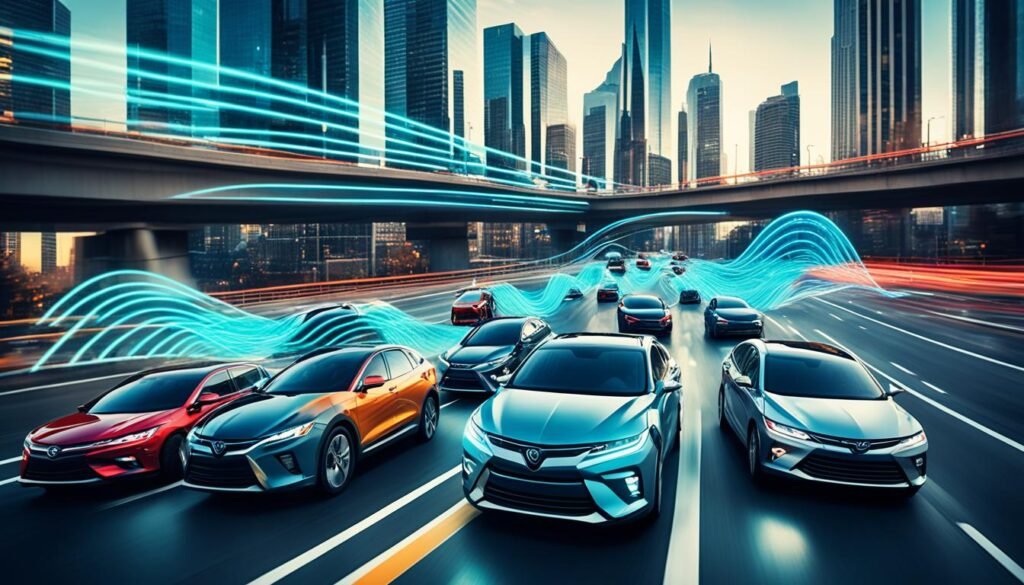
The future of automotive technology holds immense promise, and one of the most exciting developments is the concept of vehicle-to-vehicle (V2V) communication. This innovative technology enables cars to exchange critical data with one another, opening up new possibilities for improving traffic flow, enhancing road safety, and preventing accidents.
Improved Traffic Flow and Coordination
By continuously sharing information about their speed, position, and other relevant data, vehicles equipped with V2V communication can anticipate potential traffic congestion and coordinate their movements to optimize the overall flow. This real-time exchange of information allows cars to adjust their speeds, merge seamlessly, and navigate through intersections more efficiently, reducing the likelihood of bottlenecks and improving overall traffic coordination.
Accident Prevention and Safety
One of the most significant benefits of V2V communication is its ability to enhance road safety. When vehicles can communicate with each other, they can detect potential collision risks and alert drivers or even take autonomous action to avoid accidents. This data exchange can warn drivers of hazardous conditions, such as sudden braking, lane departures, or the presence of pedestrians or cyclists, allowing them to react quickly and minimize the risk of collisions.
However, the widespread adoption of V2V technology also raises concerns about data privacy and security. Governments and industry stakeholders must work together to develop robust data protection protocols and ensure that the benefits of V2V communication are balanced with the need to protect the privacy of drivers and passengers.
As the automotive industry continues to invest in infrastructure and software developments to support V2V communication, the potential to transform the driving experience and make our roads safer and more efficient is becoming increasingly tangible. By harnessing the power of data exchange between vehicles, we can pave the way for a future where traffic flows more smoothly, and the risk of accidents is significantly reduced.
Lightweight Materials and Energy Efficiency
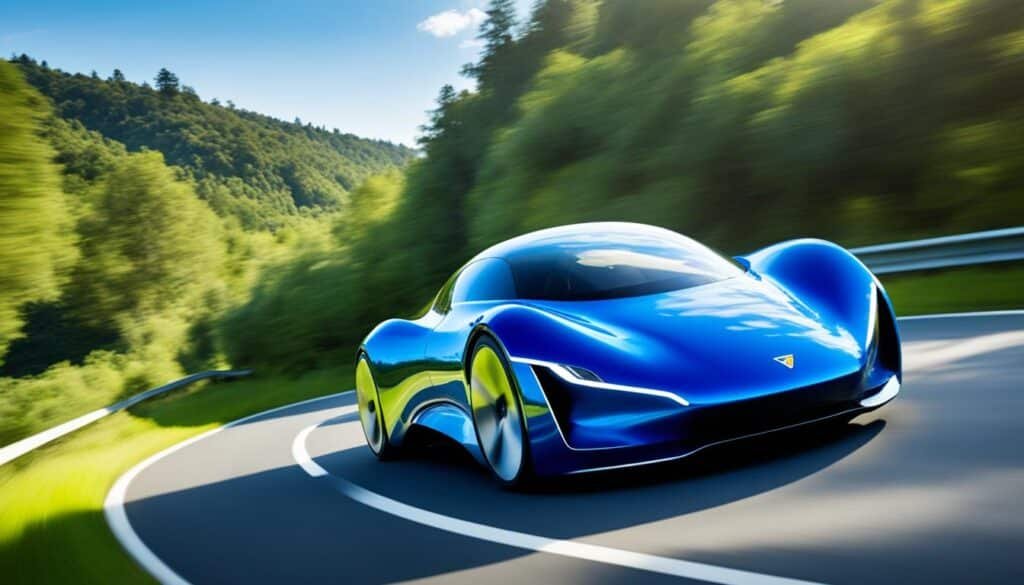
In the pursuit of enhanced fuel economy and reduced emissions, the automotive industry is exploring innovative lightweight materials and energy-efficient technologies. Automakers are incorporating materials like carbon fiber and aluminum alloys into vehicle designs to reduce weight without compromising safety or performance.
Carbon Fiber and Aluminum Alloys
The use of carbon fiber and aluminum alloys has become increasingly prevalent in modern automotive engineering. These lightweight materials offer exceptional strength-to-weight ratios, enabling automakers to create vehicles that are more energy efficient and environmentally friendly. By reducing the overall weight of a vehicle, these materials contribute to improved fuel economy and lower greenhouse gas emissions, making them a crucial component in the industry’s push for greater sustainability.
Hybrid and Plug-in Hybrid Technologies
In addition to lightweight materials, the automotive industry is also making strides in the development of hybrid and plug-in hybrid technologies. These advanced powertrain solutions combine the benefits of traditional internal combustion engines with the efficiency and emissions reduction capabilities of electric motors. The integration of these systems allows for a significant improvement in fuel economy and a reduction in the environmental impact of transportation, aligning with the industry’s goal of promoting sustainable mobility solutions.
Automotive Technology
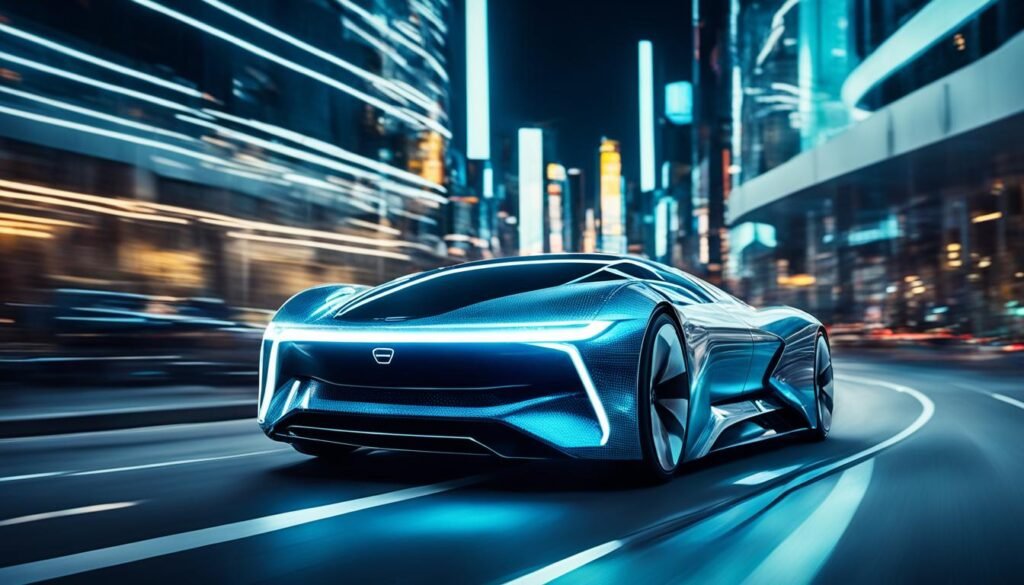
The automotive industry has witnessed a remarkable transformation, driven by the convergence of artificial intelligence (AI) and machine learning. These advanced technologies have revolutionized every aspect of the driving experience, from autonomous vehicles to personalized infotainment systems.
Artificial Intelligence and Machine Learning
AI and machine learning algorithms have become integral to the automotive ecosystem, enabling vehicles to perceive their surroundings, anticipate potential hazards, and make split-second decisions. Computer vision techniques, powered by AI, allow cars to accurately detect and classify objects, pedestrians, and road signs, enhancing overall safety and driving efficiency.
Advanced Sensor Technologies
The automotive industry has embraced a vast array of sensor technologies, including lidar, radar, and advanced cameras, to provide vehicles with a comprehensive understanding of their environment. These sensors work in tandem with AI and machine learning algorithms to enable autonomous driving, advanced driver assistance systems (ADAS), and smart city integration.
Big Data Analytics and Predictive Maintenance
The integration of big data analytics and predictive maintenance technologies has transformed the way the automotive industry operates. By continuously collecting and analyzing data from various vehicle systems and components, fleet management and vehicle diagnostics have become more efficient, allowing for proactive maintenance and personalized customer experiences.
| Automotive Technology Trends | Key Innovations | Benefits |
|---|---|---|
| Artificial Intelligence (AI) and Machine Learning | Computer vision, autonomous decision-making, predictive analytics | Enhanced safety, efficiency, and personalized experiences |
| Advanced Sensor Technologies | Lidar, radar, computer vision, sensor fusion | Improved environmental perception, autonomous driving, and smart city integration |
| Big Data Analytics and Predictive Maintenance | Fleet management, vehicle diagnostics, data-driven decision-making | Proactive maintenance, reduced downtime, and personalized customer experiences |
Embark on a career in automotive technology with our comprehensive training program. Our automotive program, offered as an Associate of Applied Science degree or certificate program, provides hands-on learning and advanced training in automotive electrical systems, fuel systems, and troubleshooting techniques. Designed to prepare students for employment in the automotive industry, our program offers industry certification from the National Institute for Automotive Service Excellence and the National Automotive Technicians Education Foundation. Whether you choose to pursue an associate degree in automotive technology or a certificate program, our curriculum covers a wide range of automotive technology courses, including electronic technology and automotive systems. With program learning outcomes focused on helping you develop the skills needed to diagnose and repair vehicles, you’ll receive training from experienced instructors and have access to state-of-the-art repair facilities. Upon completion, you’ll be prepared for a career as an automotive service technician, with opportunities to work in service and maintenance at automotive facilities nationwide. Join our program today and start your journey towards a rewarding career in the automotive field.
Also Read: Creative Technology: Innovations At The Intersection Of Imagination And Engineering
Conclusion
The automotive industry is undergoing a remarkable transformation, driven by a convergence of cutting-edge technological advancements, rising consumer demand, and a growing emphasis on sustainable mobility. As traditional Original Equipment Manufacturers (OEMs) grapple with the challenge of adapting their legacy structures to meet future requirements, a new wave of agile OEMs is capitalizing on these transformative technologies and evolving consumer preferences.
The automotive landscape is witnessing a pivotal shift towards electric propulsion, autonomous driving capabilities, and interconnected mobility solutions. Electric vehicles (EVs) are redefining the concept of sustainable transportation, with advancements in battery technology, charging infrastructure, and energy-efficient drivetrains. Autonomous driving, facilitated by sensor fusion, artificial intelligence, and advanced software, is poised to revolutionize the way we experience the road, enhancing safety and convenience.
Connected cars, empowered by vehicle-to-everything (V2X) communication, are transforming the driving experience by enabling real-time data exchange, improved traffic coordination, and enhanced personalized services. Advanced Driver Assistance Systems (ADAS) further contribute to road safety, with collision avoidance, lane departure warning, and blind spot monitoring capabilities. The integration of augmented reality and heads-up displays is reshaping the driver-vehicle interaction, providing intuitive navigation and critical information in a seamless manner.
As the automotive industry continues to embrace these technological innovations, the future of transportation is poised to be more sustainable, efficient, and personalized, with a focus on reducing environmental impact and enhancing the overall driving experience. The convergence of electric propulsion, autonomous driving, connected car technology, and smart city integration promises to redefine the way we move, ushering in a new era of mobility that prioritizes safety, convenience, and environmental responsibility.
FAQs
Q: What is automotive technology program?
A: An automotive technology program is a specialized education program designed to provide students with the knowledge and skills needed to work as automotive technicians or mechanics.
Q: What are the career options after completing a degree in automotive technology?
A: Graduates with a degree in automotive technology can pursue careers as automotive technicians, mechanics, automotive service technicians, or even work in automotive facilities.
Q: How can I become a certified automotive technician?
A: To become a certified automotive technician, you typically need to complete a certificate program or degree in automotive technology and pass certification exams such as the Automotive Service Excellence (ASE) exams.
Q: What are the advantages of hands-on learning in an automotive technology program?
A: Hands-on learning in an automotive technology program allows students to apply theoretical knowledge in real-world scenarios, enhancing their skills and preparing them for careers in the automotive industry.
Q: Is financial aid available for students pursuing a degree in automotive technology?
A: Yes, many schools offering automotive technology programs provide financial aid options such as scholarships, grants, and student loans to help students cover the cost of their education.
Q: What are the program learning outcomes of an automotive technology degree?
A: Program learning outcomes of an automotive technology degree typically include proficiency in automotive repair, engine performance, and other essential skills needed to succeed as automotive technicians or mechanics.
Q: How can I start a career in automotive technology with no prior experience?
A: You can start a career in automotive technology with no prior experience by enrolling in an entry-level automotive technology program that provides comprehensive training and hands-on experience in automotive repair and maintenance.
Source Links
- https://www.linkedin.com/pulse/driving-future-technologies-transforming-automotive-industry-ashok-0f1lc
- https://www.dennemeyer.com/ip-blog/news/driving-the-future-innovations-steering-the-automotive-industry/
- https://spanidea.com/us/blog/driving-into-the-future-exploring-the-latest-innovations-in-the-automotive-industry/




